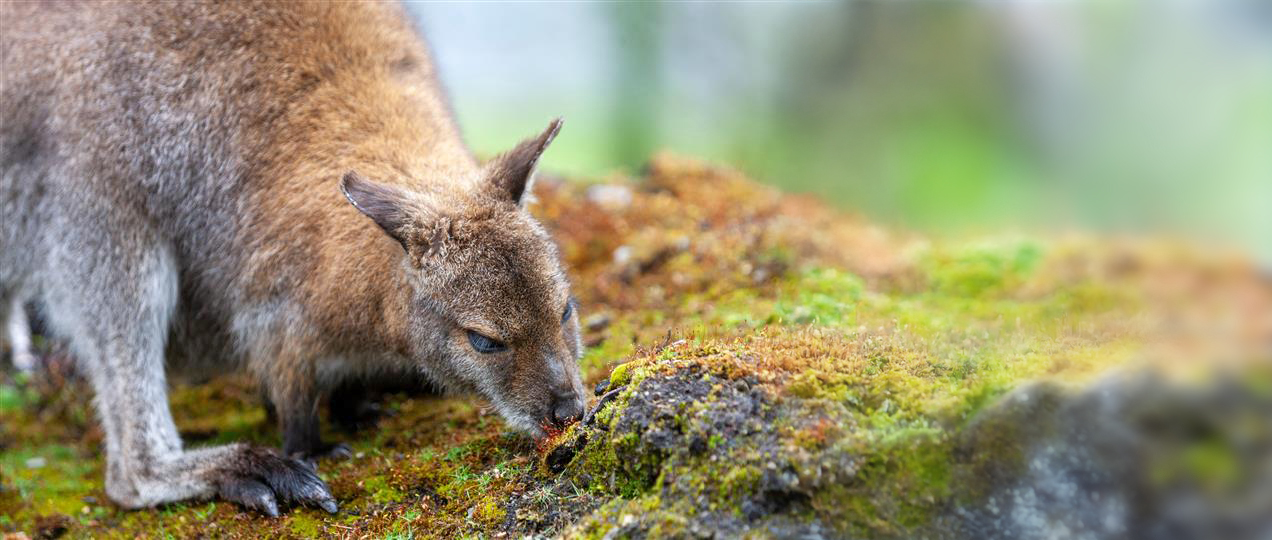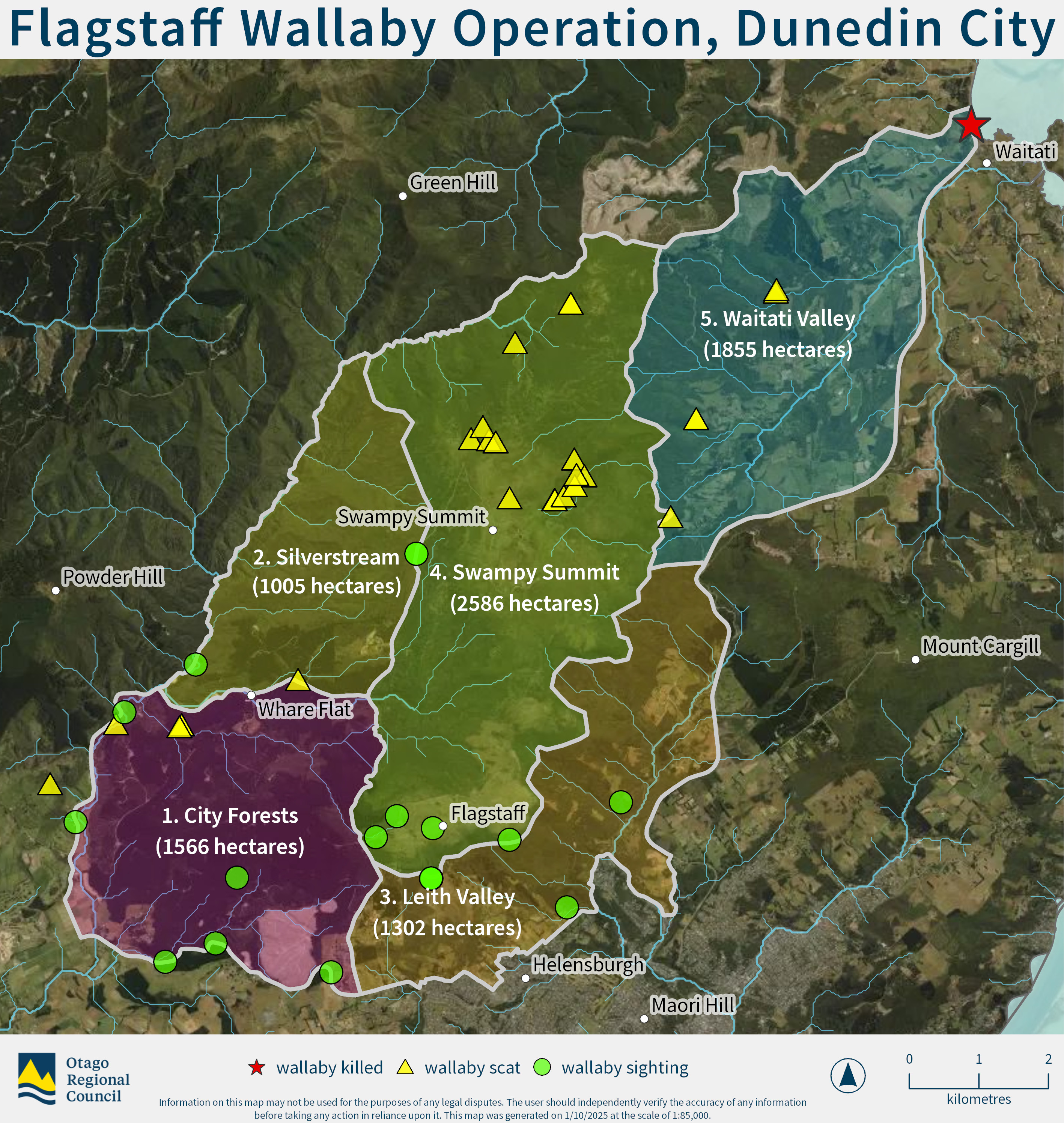
Since 2011, there have been 22 reported Bennett’s Wallaby sightings in the Dunedin area. A detailed search of the area undertaken in 2022 found wallaby scat at numerous locations across the Flagstaff area, including Silverstream, Whare Flat and Swampy Summit.
Bennett’s Wallaby is one of five wallaby species introduced to New Zealand from Australia in the late 1800s. Wallabies are herbivores and each year they cost New Zealanders millions of dollars in lost farm production and environmental damage.
In response to the continued presence of Bennett’s wallaby in the Flagstaff/Swampy Summit area, ORC have engaged High Country Contracting to undertake control operations across the 5 areas, beginning October 2025 with City Forests (area 1).
The aim is to eliminate Bennett’s Wallaby from Flagstaff.
This will be a phased operation, with surveillance carried out in separate areas from now and into 2026, beginning with City Forests. There will be no control operations without first consulting with landowners and stakeholders.

High Country Contracting will contact landowners within the project area to discuss the operation and complete private property permission agreements to confirm access and any conditions associated with that access. The agreements outline the various methods and the obligations of both the contractor and the landowner or occupier.
For landowners who have given permission, you will be contacted if surveillance has determined that wallabies are in the area and control work needs to be undertaken. The contractor will discuss the options for control with you to confirm access and any conditions associated with that access.
For properties where landowners have not agreed to control on their property, no control will be undertaken. Notice will also be given to landowners directly adjoining any treatment area prior to any control being undertaken.
Signage is to be placed at public land entrances to alert visitors and will remain for the duration of the project.
We have prepared the following FAQ based on the most current information available. This will continue to be updated.
The project will take an adaptive management approach, and there may be adjustments to timelines, tools and methods with lessons learnt incorporated into the project as the operation progresses.
Bennett’s Wallaby is one of five wallaby species introduced to New Zealand from Australia in the late 1800s. Wallabies are herbivores and each year they cost New Zealanders millions of dollars in lost farm production and environmental damage.
The presence of Bennett’s Wallaby poses a major biosecurity risk to our region’s primary industry and the natural environment. Otago has a chance of eliminating this pest as they are still in relatively low numbers here.
The aim is to eliminate wallaby from Flagstaff, but resources mean we may only be able to destroy those that we do find.
The Tipu Mātoro National Wallaby Eradication Programme, led by Biosecurity New Zealand, is providing approximately 85% of the operation’s funding. The remaining funding is being provided by ORC.
Biosecurity New Zealand is a unit within the Ministry for Primary Industries (MPI) and is responsible for managing New Zealand's biosecurity system. Biosecurity New Zealand’s funding is essential to the viability of this operation.
Further information on the Tipu Mātoro National Wallaby Eradication Programme can be found on the MPI page.
The success of this operation depends on the support of the local community.
Your help in reporting wallaby is invaluable to their detection and control, and helps protect our native forests, farmlands and iconic landscapes. If you've seen a wallaby, dead or alive, report it at reportwallabies.nz
You can find handy info to ID wallabies on the MPI How to identify pest wallabies webpage.
High Country Contracting (or HCC) have been engaged by ORC to undertake this operation in the Flagstaff / Swampy Summit area.
High Country Contracting is a well-established animal pest, plant pest, and native restoration company based in the rural south, delivering highly successful programmes to a diverse range of customers. You may see the friendly High Country Contracting team of operators searching around the Flagstaff, Silverstream, Leith Valley, Swampy summit and Waitati areas.
Further information on HCC can be found on their website: rentokilruralenvironmental.co.nz
Professional hunters will be used to search for wallaby and wallaby sign, which may include the use of dogs, drones, and trail cameras. Surveillance will be conducted in accordance with regulatory and legislative requirements, animal welfare guidelines and best practice methods.
No surveillance will be undertaken without first consulting with landowners and stakeholders, and ensuring signage is in place at public land entrances to alert visitors to the work.
Dogs: Dogs trained to detect wallabies may be used to assist teams to locate wallabies, assist hunters in control and be used to inform if areas are free of wallabies (before moving to the next area). All dog handlers (and dogs) have undergone assessment to ensure effective handling competency, dog obedience, dog welfare, and target specificity to meet the standards required by the Tipu Mātoro National Wallaby Eradication Programme and New Zealand laws (Ministry for Primary Industries' (MPI) Code of Welfare: Dogs and Animal Welfare (Care and Procedures) Regulations 2018). This includes rigorous, ongoing training to ensure the handler can safely and effectively manage the dog, the dog is well-controlled and not a nuisance, the animal's welfare is protected, and the dog specifically targets wallaby without harming non-target species or causing distress to people.
Drones: Drones with thermal detection will be used to locate wallaby in selected areas, and to assist with hunting. Drone operators must comply with the relevant New Zealand laws (the Civil Aviation Act 2023), hold the necessary certification from the Civil Aviation Authority (Part 102 Unmanned Aircraft Operators Certificate), and pilot qualifications (Remotely Piloted Aircraft System – RPAS Part 102 Pilot Certificate and RPAS Pilot Night Rating) to operate drones safely, legally and effectively, and to minimise the potential risks involved. All drone operations must ensure the aircraft is safe, well-maintained, and equipped with proper anti-collision lighting. Permission will be obtained from all land occupiers and/or agencies responsible for any areas the drone is flying above.
Cameras: Wildlife trail cameras will be located in discrete locations to detect wallabies and track the progress of the operations. Any footage containing an identifiable individual will be deleted immediately (unless any criminal activity is detected in which case footage will be provided to the New Zealand Police or other relevant enforcement agency).
Professional hunters will be used control wallaby. Control methods may include shooting or using toxins and will depend on the area wallaby are found and the need to ensure public safety. All wallaby control will be conducted in accordance with regulatory and legislative requirements, animal welfare guidelines and best practice methods.
No wallaby control will be undertaken without first consulting with landowners and stakeholders, and ensuring signage is in place at public land entrances to alert visitors to the work and any risks.
Shooting: Shooting will be a key tool used to remove wallaby in most areas, subject to approval from the relevant landowner or organisation responsible e.g. DCC, DOC. Professional hunters will be engaged to undertake any shooting required and will be required to comply with New Zealand firearm laws (the Arms Act 1983 and the Arms Regulations 1992), codes of practice (Firearms Safety Code) and licensing requirements, and adhere to Standard Operating Procedures (SOP) detailing the safe storage, transportation, maintenance, and use of a firearm.
Toxins: If agreed to by individual landowners, targeted toxins may be used in areas where wallabies are found to inhabit. Professional hunters laying toxins for wallaby control must adhere to stringent legislative and licensing requirements under New Zealand laws, using registered toxins only, obtaining all necessary permissions from public health and conservation authorities, following label instructions, ensuring proper notification and signage, and following Standard Operating Procedures (SOP) on the safe handling, use, storage and disposal of toxins.
Every pet is different, and as an owner, you know best how to manage your pet’s safety. There is a risk to dogs that tend to scavenge, particularly during operations in your area.
Communication is key and signage will be in place to keep the public informed about the specific area where control is being carried out.
It is advisable when out walking to use a lead and a muzzle in the designated risk areas. If you need help keeping your pet safe, please ask the project team for assistance.
If you have the option, we recommend you avoid bringing your dog into the operational area during the operational period.
ORC and High Country Contracting are required to work under strict regulatory and legislative standards. This includes consultation with key stakeholders, Dunedin City Council, DOC, City Forests and affected landowners, and providing regular updates to the public and landowners as the operation progresses.
We’re committed to keeping the public and landowners up to date and to listening to your feedback. If you have questions, our operations staff can be contact through ORC customer service.
From initial consultation to wallaby removal and confirmation of absence, it is estimated the operation will take 12 months. However, there may be the need for some flexibility to the schedule, with possible date adjustments, including re-visiting ‘hotspot’ areas of wallaby activity.
The proposed timeline to survey and control wallaby in each area (if found) is as follows:
|
Area |
Area Name |
Estimated Timing |
|
1 |
City Forests |
13 October 2025 to 7 November 2025 |
|
2 |
Silverstream |
10 November 2025 to 5 December 2025 |
|
3 |
Leith Valley |
8 December 2025 to 23 January 2026 |
|
4 |
Swampy Summit |
26 January 2026 to 13 March 2026 |
|
5 |
Waitati Valley |
16 March 2026 to 22 May 2026 |
While specific details for disposal vary, the goal is to manage the carcasses in a way that prevents further harm, especially to other animals. If toxins are used, a caution period will apply and dog owners will be advised to avoid the area to prevent their dogs from scavenging on any carcasses.
Success will be measured by the absence of any sign of wallabies. Monitoring for individual wallabies may continue for up to approximately one year after the last individual is removed. Surveillance monitoring will include:
- Community eyes and ears: Your sightings of wallabies will be pivotal in confirming their presence or absence. If you see a wallaby, dead or alive, report it at reportwallabies.nz
- Cameras: Wildlife trail cameras will be used to help confirm wallaby presence or absence. Cameras may also be moved around to ‘hotspots’ where we suspect animals may remain.
- Drones: In suitable habitats, and with landowner approval, drones will be used to confirm wallaby presence or absence.
- Dogs: Indicator dogs and their handlers will check areas for wallaby presence.
- Environmental DNA: This relatively new technique may be used to detect traces of genetic material from wallaby in water or air to provide confidence of absence. For example, if no wallabies have been detected for a period of time, we should expect no traces of their DNA in the water or air.
If you have questions about this operation, please contact us: customerservices@orc.govt.nz

